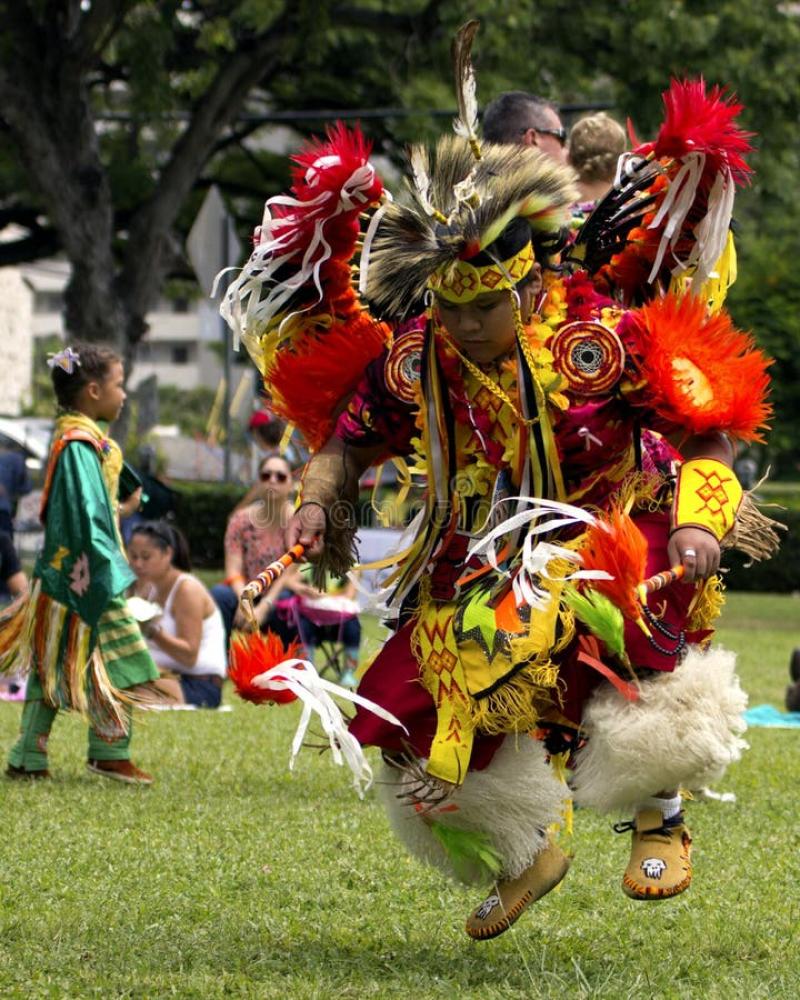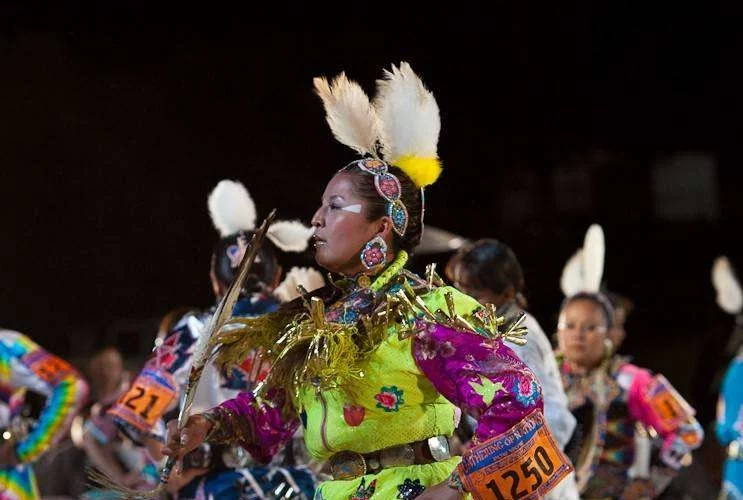Mixing Hip Hop with Traditional Native American Dances

Native Americans have many traditional dances, two of the most popular are the Mens Fancy Dance and the Woman's Jingle Dance. Both have widespread audiences across the US and Canada with some moving into Mexico and Central America.
There are contests across the nation for the best of each of the many Native Dances with large cash prizes. In addition to the dance itself which all have a specific meaning or history there are the regalia that the dancers wear and it is worth thousands of dollars and is incredibly intricate in it's design.Me
The Mens Fancy Dance is relatively new and it comes from the Ponca Tribe.
The Fancy Dance
 ARTIST: JIM BROWN
ARTIST: JIM BROWN
MEDIUM: Exterior Acrylic Latex
“The first observation of this dance is how the colorful regalia and movements are vibrant and full of life. This mirrors what life can be, when you push past the struggles and dark times and find what is good with what we have been given.
The sunrise gives us hope for what the day brings us and the sunset is a celebration of the accomplishments since the first morning glow. The dance is your spirit that moves you forward."
Men’s Fancy Dancers
Fancy dance, Pan-Indian dancing, Fancy Feather or Fancy War Dance is a style of dance some believe was originally created by members of the Ponca Tribe in the 1920’s and 1930’s, in an attempt to preserve their culture and religion. It is loosely based on the war dance. Fancy dance was considered appropriate to be performed for visitors to Reservations and at "Wild West" shows. But today, fancy dancers can be seen at many powwows across the nation and even the world.
Men's fancy dance is flashy, colorful and highly energetic. It requires strength and stamina and is usually performed by younger men and boys. The drum can play a medium war beat, a ruffle, crow hop, and a fast beat. It is always expected that a fancy dancer should do a pose at each end of the beat. Some might do splits or stop in mid-air. Male fancy dancers typically wear brightly colored regalia. Twin feather bustles are one of the hallmarks of modern fancy dance regalia, along with a beaded bodice, leggings or breech cloth and side tabs (most popular), bells just below the knees, Icelandic sheep hair or also known as "Goats", moccasins, a roach with two feathers (most wear a roach rocker which rocks the feathers with the dancer's movements), beaded cuffs, beaded headband, and other feathered or beaded accouterments. The regalia often has a fringe of many colors. The old style regalia is making a comeback.
The women's fancy shawl dance represents the opening of a cocoon when the butterfly emerges. The shawl is usually the most extravagant piece. The fringed shawls are colourful and flashy, often featuring embroidery or ribbon work. The fringe on the shawl have movement that coincides with the dancer. The dancers usually wear beaded or appliqued designs, and beaded hairpieces. Chokers, earrings, bracelets, and eagle plumes are usually worn as well. Elaborate moccasins and leggings complete the regalia. The practice of women's fancy shawl dance is far more recent than that of men's fancy dance. It wasn't until fancy dance had existed for several decades that women began to participate.
Information provided by Elder Lance Scout, Kainai - Blood Tribe
ReferencesEllis, Clyde. A Dancing People: Powwow Culture on the Southern Plains. Lawrence: University of Kansas Press, 2003. ISBN 0-7006-1274-2.
Jingle Dress Dance | Native American Meaning and History

July 21, 2011 / November 27, 2023 by Paul G | 18 Comments on Jingle Dress Dance | Native American Meaning and History
In the heart of First Nations and Native American communities, a captivating and rhythmic tradition known as the Jingle Dress Dance has endured through generations.
Steeped in rich history and cultural significance, the Jingle Dress Dance has evolved from a healing ritual into a source of immense pride. Its origins trace back to the early 1900s with the Mille Lacs Band of the Ojibwe Tribe, blossoming in the 1920s across regions like Wisconsin, Minnesota, and Ontario, Canada. The story behind its inception is a testament to its healing power—an indigenous medicine man's granddaughter fell ill, prompting him to craft a Jingle Dress at the behest of spirit guides. They prophesied that the dress would heal the child when she danced in it. The tribe came together to witness this magical transformation, a symbol of resilience in the face of adversity, particularly during the 1918 flu pandemic and the subsequent federal ban on ritual dancing at Indian reservations in the 1920s.
Join us on a journey through the past and present, where the Jingle Dress Dance continues to mesmerize and heal, embodying the resilience and cultural pride of indigenous communities.
The Jingle Dress Dance is commonly seen in competitive pow wows, performed by women and girls in First Nations and Native American communities.
The dance gets its name from the rows of metal cones —called “ziibaaska’iganan”—attached to their dresses, which make a distinctive sound as they dance. The ritual has a rich history, and there are few sights as mesmerizing as watching and hearing the women perform the light, elegant dance style in their Jingle Dresses.

Find Pow Wows Near You
Pow Wows in all 50 states and Canadian Provinces! Experience Pow Wows in 2024!
Read on to learn everything you need to know about the Jingle Dress Dance.
History of the Jingle Dress Dance
The Jingle Dress Dance began with the Mille Lacs Band of the Ojibwe Tribe in the early 1900s and became prevalent in the 1920s in Wisconsin and Minnesota (Great Lakes region) in the US and in Ontario, Canada.
The story is that the dress was first seen in a dream. A medicine man’s granddaughter grew sick, and as the man slept his Indian spirit guides came to him and told him to make a Jingle Dress for the little girl. They said if the child danced in it, the dress would heal her.
The Jingle Dress was made, and the tribe came together to watch the child dance. At first, the child was too sick to dance alone so her tribe carried her, but after some time, the little girl was able to dance alone, cured of her sickness.
It’s likely that the sickness the little girl was experiencing was a part of the 1918 flu pandemic, which hit the Native American communities hard close to the Great Lakes. This was closely followed by a federal ban on ritual dancing at Indian reservations in the 1920s. The dance has since been not only a ritual of healing but also one of pride.
Back in 2018, the Mille Lacs Indian Trading Post and Museum even launched an exhibit with photos commemorating the epidemic and the 100th anniversary of the dress and dance. The exhibit, which sheds light on the history of the Jingle Dress and Dance, was developed in partnership with the University of Minnesota Department of American Studies and the Mille Lacs Ojibwe community.
Though the dance started with a grandfather and a little girl more than a century ago, the style is now performed competitively and in ceremonies by women and girls of all ages.
What Do Jingle Dresses Look Like?
Jingle Dresses, also known as Prayer Dresses, are believed to bring healing to those who are sick. As mentioned above, the dance gets its name from the rows of ziibaaska’iganan (metal cones) sewed to the dress. These cones are traditionally made from rolled snuff can lids and hung from the dress with ribbon close to one another, so they make a melodic sound as the girls and women dance. Traditionally, the dress is adorned with 365 visible jingles, or cones. Nowadays, these cones are often machine-made.
The dresses come in every color imaginable, from yellow to bright blue, to deep red, and accented with sparkles and even neon-colored fabrics. They are often made with shiny and sparkly materials and decorated with fringes, embroidery, beading, and more.
They usually have three-quarter length to full-length sleeves and come down to mid-calf or the ankle. They are secured at the waist with a thick belt, often made of brown leather. On their feet, the dancer wears decorative moccasins embellished with the same kind of detail found on their dresses.
Traditionally, the dresses were often made from old formalwear and other repurposed dresses and didn’t include the decorative beadwork, or the beaded leggings we see today on and beneath the dresses.
What are the steps for the Jingle Dance?
As the ziibaaska’iganan hit one another it sounds like rain falling, so it’s important for the dancer to be light on their feet, to move in time with the drum and stop when the beat stops. They keep their foot movements low to the ground while dancing, kicking their heels and bouncing on their toes to the music. Typically, this dance is done in a zigzag pattern, said to represent one’s journey through life—or so the story goes.
The traditional Indian dance involves low, soft-footed steps, as could be performed by those who were sick, while the modern competitive dancers push the boundaries some as they try to out-dance their competitors. The manner in which the dance has evolved has built firmly on its origin story .
What are the songs and music for Jingle Dance?
The music for this style of dancing has a foundation of a solid drumbeat, and of course, the metal cones make a loud jingling (hence the name) as the women move, which contributes to the music you’ll hear at a Jingle Dress Dance.
Jingle Dancers will usually dance to Northern drum groups. Special songs for Jingle Dance include a Side Step or Crow Hop.
OFF-TOPIC COMMENTS WILL BE DELETED WITHOUT WARNING.






OFF-TOPIC COMMENTS WILL BE DELETED WITHOUT WARNING.
ENJOY AND HAVE SOME FUN.
As a point of interest, the article mentions that the jingle dance was because of the Spanish Flu which ravaged the tribes in MN. My nookomis (grandmother on my mother side) died from the Spanish Flu in 1918 along with her one day old daughter. My nookomis name was Whirling Girl (she was a great dancer)